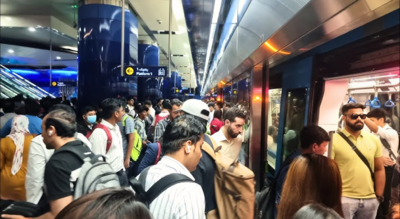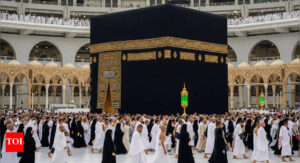In just six months, Dubai’s transport system carried more people than the entire US population | World News

- Dubai saw 395.3 million public transport rides in H1 2025, up 9% from 2024.
- Metro (36.5%) and taxis (26%) made up most of the ridership.
- The new Blue Line will serve 1M residents across 14 stations.
- Dubai aims for a fully electric/hydrogen bus fleet by 2050.
It’s remarkable to consider that Dubai, a city with a population of roughly 11.3 million, recorded an astonishing 395 million public transport rides in just the first half of 2025. To put this into perspective, this figure surpasses the entire population of the United States, around 347 million, by a significant margin. In fact, the number of rides is about 35 times greater than the total population of the UAE itself. This striking statistic offers a glimpse into Dubai’s rapidly evolving public transport landscape, revealing a system that has become integral to daily life for residents and visitors alike.
Dubai’s Public Transport: A Growing Backbone of Mobility
On July 27, 2025, Dubai’s Roads and Transport Authority (RTA) announced the impressive figures for public transport ridership during the first six months of the year. The numbers span across multiple transport modes including the Dubai Metro, Dubai Tram, public buses, marine transport, as well as taxis and shared mobility options such as app-based vehicles, hourly rentals, and on-demand buses. The total ridership reached approximately 395.3 million, marking a 9% increase over the roughly 361.2 million rides recorded during the same period in 2024. Average daily ridership climbed to nearly 2.18 million, up from about 1.98 million daily rides the previous year. Mattar Al Tayer, Director General and Chairman of the Board of Executive Directors of RTA, emphasized the importance of this growth. He said, “The continued growth in public transport ridership reflects users’ confidence in the system’s efficiency and the quality of services provided across all modes. We remain committed to delivering safe, comfortable, and sustainable mobility solutions for every segment of society.” Al Tayer highlighted that Dubai’s public transport network has undergone a major transformation. “Driven by advanced infrastructure and a diverse range of transit options,” he explained, “the network now forms the backbone of mobility for residents and visitors across the emirate.” Notably, the share of journeys using public transport and shared mobility options has increased from just 6% in 2006 to 21.6% in 2024, a clear indication of shifting public attitudes toward sustainable and convenient mass transit.
Expanding Infrastructure and Environmental Commitments
Looking ahead, Dubai is actively expanding its transit system. The ongoing construction of the Dubai Metro Blue Line is a major project, set to add 30 kilometers and 14 new stations. The line will serve nine key districts housing an estimated combined population of one million residents, aligning with the broader Dubai 2040 Urban Plan. Al Tayer revealed that the RTA is pursuing a strategic vision to make public transport the preferred choice for daily commuting. “We are moving forward with a clear vision to make public transport the preferred choice by smartly expanding transport lines and networks, strengthening connectivity between stations and key destinations, and offering flexible, inclusive mobility solutions.” In line with environmental goals, the RTA recently signed four agreements to procure 637 multi-sized buses compliant with the European low-emission standard ‘Euro 6.’ This includes 40 electric buses, making it the largest and first fleet of its kind in the UAE. These buses, expected to be delivered in 2025 and 2026, will support geographic expansion and help achieve the long-term target of converting the entire public bus fleet to electric and hydrogen-powered vehicles by 2050. This month, the RTA also completed the development of 16 bus passenger stations and six depots to enhance service quality.
Ridership Breakdown: Metro, Taxis, and More
During the first half of 2025, the Dubai Metro and taxis accounted for the largest shares of ridership, contributing 36.5% and 26% of total trips respectively. Public buses remained vital, making up 24% of overall ridership. May was the busiest month, with ridership peaking at 68.8 million trips, while the other months ranged between 61 million and 68 million rides. Reflecting on these figures, Mattar Al Tayer said:“There was a 9% increase in ridership during the first half of this year compared to the same period in 2024, a key indicator of the recovery in economic activity across the emirate of Dubai, as well as the effectiveness of the RTA’s strategies and initiatives to encourage both residents and visitors to use public transport and to offer diverse mobility options throughout the city.” Breaking down the metro ridership further, the Dubai Metro recorded approximately 143.9 million riders across its Red and Green Lines. The stations with the highest traffic were:
- BurJuman Station (serving both lines) with 8.6 million riders
-
Al Rigga Station with 6.8 million riders - Union Station with 6.6 million riders
On the Red Line, the busiest stations after Al Rigga were:
- Mall of the Emirates Station with 5.6 million riders
- Burj Khalifa/Dubai Mall Station with 5.4 million riders
- Business Bay Station with 5.3 million riders
On the Green Line, the most popular stations included:
- Sharaf DG Station with 5.1 million riders
- Baniyas Station with 4.1 million riders
- Stadium Station with approximately 3.6 million riders
Additional modes of transport contributed significantly as well. The Dubai Tram carried 4.9 million riders, while public buses served 95.7 million passengers. Marine transport modes collectively transported 9.7 million users, shared mobility services—including app-based vehicles and on-demand buses, accounted for 37.6 million rides, and taxis carried 103.5 million riders during this period.
The Dubai Metro Blue Line: A Landmark Development
The Dubai Metro Blue Line is poised to become a vital addition to the city’s transport network. Stretching 30 kilometers with 14 stations, it will improve connectivity between key areas such as Mirdif, Dubai Silicon Oasis, Dubai Creek Harbour, and Dubai Festival City. The line is designed to handle a maximum capacity of over 850,000 passengers per day, with projections estimating 200,000 daily passengers by 2030 and 320,000 by 2040. A notable highlight is the Emaar Properties station, which will be the tallest metro station in the world at 74 meters high, symbolizing Dubai’s ambition to combine cutting-edge infrastructure with architectural excellence. Dubai’s public transport success story is a testament to visionary planning, significant investment, and a steadfast commitment to sustainability and inclusivity. From a modest 6% public transport share in 2006 to becoming a city where nearly 2.2 million rides are taken daily in 2025, Dubai is redefining urban mobility on a scale that rivals entire nations.








